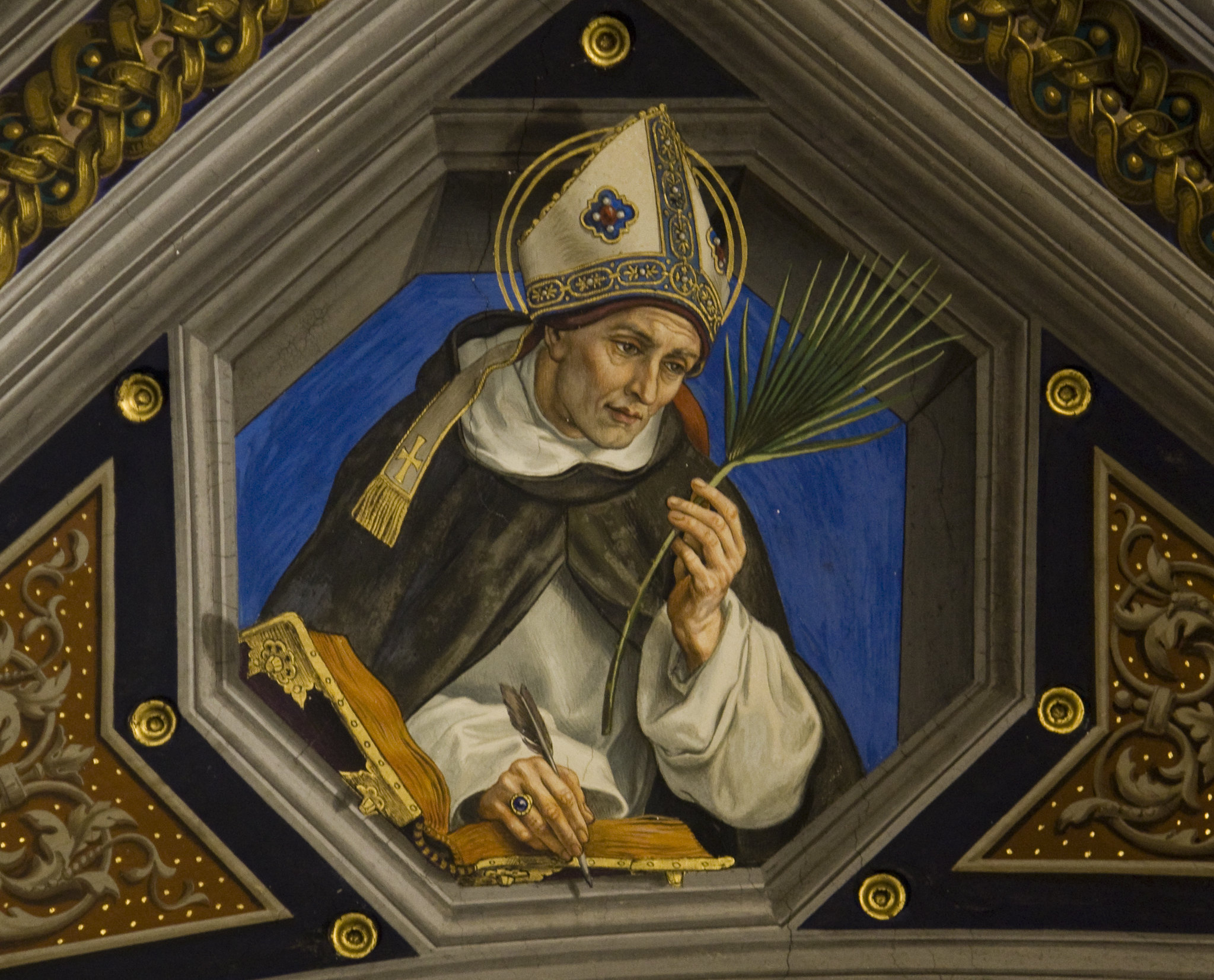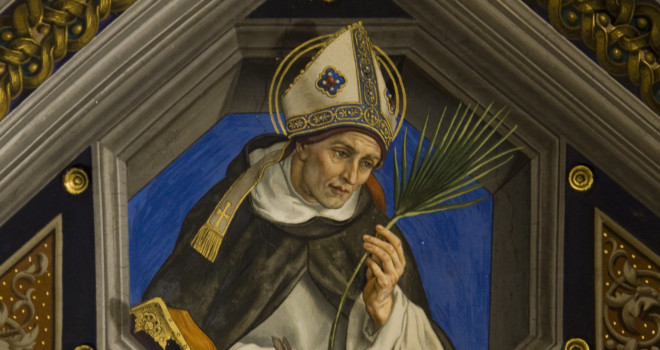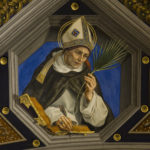St. Albert the Great: Saintly Scientist for the Modern World
Born on earth around 1200 and in heaven in 1280, Saint Albert the Great of the Order of Preachers is a great saint for our time so badly in need of his preaching and teaching. We live in a world where many scientists proclaim their lack of belief in God and increasing numbers of young […]



Born on earth around 1200 and in heaven in 1280, Saint Albert the Great of the Order of Preachers is a great saint for our time so badly in need of his preaching and teaching. We live in a world where many scientists proclaim their lack of belief in God and increasing numbers of young people declare they believe in science rather than religion, assuming in the ignorance of their miseducation that the two must be opposed.
As Pope Saint John Paul II declared in 1998 in his Fides et Ratio (on the relationship between faith and reason), we live in a day when scientism grows rampant and many people believe that science and technology provide all the answers to all the problems that plague humanity. On the other hand, some Christians who recognize that science can certainly tell us how to do things, but not whether we ought to do them, fall into the opposing error of fideism, “which fails to recognize the importance of rational knowledge and philosophical discourse for the understanding of faith, indeed for the very possibility of belief in God.” We live in a day of increasing polarization, presented with the false dichotomy of having to choose between the scientism of the intelligent, courageous, and godless secular scientists and the fideism of ignorant, benighted, and bigoted fundamentalist Bible-thumpers.
The Catholic Church, however, has never been the Church of either-or but of both-and insofar as there are kernels of truth in each side. John Paul II in our time would describe faith and reason as the “two wings on which the human spirit rises to the contemplation of truth.” And among the Catholic faithful throughout the centuries, few have embraced and proclaimed the inherent harmony of science and faith, of reason and revelation, like our hounds of the Lord, true champions of faith and reason, the sons and daughters of Saint Dominic de Guzman.
On November 15, 1980, eighteen years before he released Fides et Ratio, the same saintly pope previewed some of his profound thoughts on the fundamental complementarity of faith and reason in a speech in Cologne, Germany. The occasion was the seven hundredth anniversary of the death of none other than Saint Albert the Great. John Paul II praised Albert for his virtue of courage in championing man’s reason as a grand instrument to find truth and to shape and structure the world, and also for his virtue of humility to recognize reason’s limits and remain “open to the Word of eternal Truth, which became man in Christ.”
Almost thirty years later, in an address on March 24, 2010, Saint John Paul II’s successor, Pope Benedict XVI, would again recommend to us the virtues of Saint Albert, portraying Albert (named the patron saint of scientists by Pope Pius XII in 1941) as a model for modern scientists to follow in transforming the study of nature into a fulfilling and “fascinating journey of holiness.” Indeed, Pope Benedict spoke of the “friendship” of reason and faith, of Saint Albert’s realization that reason and Scripture are completely compatible, and of God’s will that we are to use both to seek and attain truth and happiness.
As when we celebrated the eight hundredth Jubilee of the Orders of Preachers on December 22, 2016, we need the model and lessons of Saint Albert even more as the world questions and “deconstructs” moral and existential truths that seemed to be settled ages ago. “What does it mean to be a man or a woman?” “What is the nature of marriage?” “Do things really have identities or natures of their own, or is everything a matter of change and flux, of feelings and shifting opinions?” “Can truth be determined by a vote or by a show of hands?” Indeed, our world increasingly asks, much as a hand-washing Roman governor once asked Truth to His face, “What is truth?” (John 18:38).

Let us turn now to this great hound of the Lord who chased away countless threatening errors and hunted down an amazing bounty of truths that we so desperately need to reclaim as we examine the thinking of this tireless thinker, the doing of this indomitable doer, and the fervent loving acts of this most learned lover.
Albertus Magnus: Thinker
Born sometime between 1193 and 1206, Albert of Lauingen lived through fourth-fifths of what has been called “the greatest of centuries” and bore the title of Magnus (the Great) while he was still alive . This accolade was due to his incredible breadth of knowledge and mastery of virtually every scientific discipline known to man at the time — literally from A to Z, with contributions to fields as diverse as anatomy, anthropology, astronomy, biology, botany, chemistry, dentistry, geography, geology, medicine, physiology, physics, psychology, and zoology. Some said that Albert knew all that there was to know! Indeed, Albert’s knowledge as a scientist was matched by his knowledge of philosophy and theology too. He became the world’s foremost academic professor and a hound of the Lord all the while.
So how did Great Albert get to be so great? To examine Saint Albert the thinker, we should start with young Albert the student. Albert’s parents were of the lower nobility and apparently died when he and his siblings were relatively young. Albert was raised by his uncle. Although we don’t have much detail on his early education, formal education was fairly rare at the time, a blessing reserved to the relatively well off and provided by teachers at the local cathedral or monastery. He would have likely received the lasting benefits of a medieval system of education based on the seven classical liberal arts. These consisted in the first years of the trivium (from tri, “three,” and via, “roads”) of grammar, dialectics or logic, and rhetoric, and later, of the quadrivium (four roads) of music theory, astronomy, geometry, and mathematics. Greek and Roman educators believed the trivium provided the fundamental tools for thinking that prepared one for adult life and that set the stage for all future specialized knowledge. Medieval educators agreed (and perhaps we would be better off if more modern ones did too!) .
By learning the nature of inflected Latin, Albert grew to understand the fundamental nature of all languages. By learning logic, he discovered how to differentiate valid from invalid arguments and truths from falsehoods, so essential to Scholastic methods of higher education. By learning rhetoric, he saw the importance of carefully defining terms, the importance of a powerful memory, and the necessity of and methods for tailoring one’s preaching or teaching to one’s audience. We can see that the trivium was anything but trivial to Albert, since as a young man he chose to hone these tools of learning further by pursuing advanced education in the trivium and quadrivium at the University of Padua, the world’s foremost center of learning of the liberal arts.
Albert’s interest in learning was by no means limited to the formal classroom either. He was constantly enthralled by the creation all around him, showing great interest in plants, in animals of all sorts, including the fish in the Danube, in the terrain of the earth, and in the motion of the heavens. Indeed, it has been said that one could repopulate the forests of Bavaria with the plants and animals that would be described in Albert’s books.
Struggling student?
Some interesting legends surround Albert’s early academic career as a student. One suggests that young Albert was not exactly a whiz kid, perhaps providing hope for those with high hopes and average intelligence! The story holds that early on at Padua, Albert had a hard time learning science. Everything that he had learned in the evening seemed to vanish from his mind by the time he woke up the next morning. Then one day his room shone brightly as Saints Catherine and Barbara and the Holy Virgin Mary suddenly appeared before him. The Blessed Mother asked him what he desired, and Albert responded by asking her for vast knowledge of human wisdom. The Holy Virgin responded that she would give him philosophical learning without equal.Further, addressing a common concern of the day, she told Albert that his human knowledge would never draw him away from the Faith. Finally, she told him that before the end of his life on earth, his knowledge would leave him and he would return to God as simple and innocent as a child.
The biographer Joachim Sighart speculates that stories about Albert’s difficulties in learning may have arisen because he spent so long in his studies. Saint Dominic, for example, with less interest in scientific knowledge, studied philosophy for six years, while Saint Albert’s philosophical studies may have lasted as long as ten years. Further, Saint Albert himself had written that he always felt inspired to study by the Virgin Mary and what he could not master through study came to him through prayer.
In 1248 Albert was appointed regent at a new Studium Generale back in Cologne. Our learned hounds of the Lord had multiplied so rapidly that the order’s only center of higher studies at the Convent of Saint James in Paris could hardly kennel and train all four hundred to five hundred of them! One of the goals of the order’s general chapter meeting in Paris that year was to establish additional houses of higher study in several Dominican provinces at Bologna for Italy, Montpellier for Provence, Oxford for England, and Cologne for Germany. Who better to establish the Dominican mini university of Cologne than Great Albert of Cologne himself? (And who better to accompany him as his aid than the young Thomas Aquinas?) There at Cologne, Albert’s genius, as well as his sanctity, and the “force of his doctrine” drew students and scholars from around the world. It is no surprise, then, that two years later we find Albert at Vincennes in northern France, helping draft the official system of study for the Order of Preachers.
Profound philosopher
As a teacher, Albert deftly passed on to his students the fruits of his contemplation, and his formalized scientific and philosophical contemplation of the works of creation continued well into his eighth decade. Albert not only studied and passed on what great thinkers had unearthed; he unearthed a good deal of new knowledge of his own. He introduced the brilliant works of Aristotle to the West in his meticulous, line-by-line commentaries on many of Aristotle’s works, works that some feared threatened the Faith, since Aristotle reasoned, for example, that the universe was eternal and that God did not take interest in human affairs.
Albert faithfully reported what Aristotle truly taught, the bulk of it being magnificent and in harmony with the truths of the Church. In his own later works, Albert was anything but a parrot of Aristotle’s opinions in science and philosophy, however, contradicting him at times in specific matters (e .g ., the frequency of lunar rainbows, the number of human ribs, and the dietary preferences of eels!) through his own experience or experimentation. Indeed, Albert even wrote a treatise on Aristotle’s errors.
In the fields of science, or “natural philosophy,” Albert was without peer in his day in his research and prolific writing; he wrote entire books on animals, vegetables, and minerals, for a few examples. His knowledge of chemistry and mineralogy sprouted myths that Albert was a great magician. Indeed, books about Albertus Magnus as magician (perhaps in part confusing magnus, “great,” with magus, “magician”) are still on the market today!
Albert was one of history’s greatest thinkers . We have provided but the smallest of nutshells here, although the mighty oak of his encyclopedic knowledge can’t help but be seen in how it branched out far and wide into his activities as a doer and a thinker.
✠
Editor’s note: This article is adapted from a chapter in Dr. Vost’s Hounds of the Lord: Great Dominican Saints Every Catholic Should Know, which is available from Sophia Institute Press.














